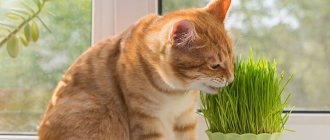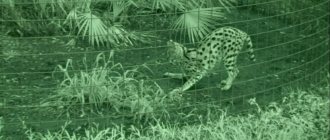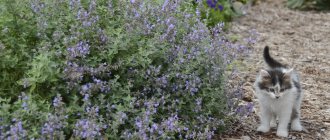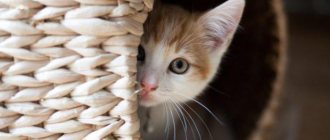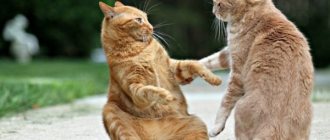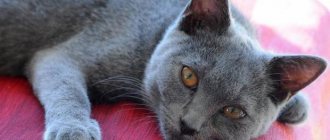Due to curiosity or lack of vitamins, domestic cats tend to chew the leaves of house plants. A seemingly harmless habit can turn into a tragedy due to the toxic substances contained in plants. What are the dangers of poisonous plants for domestic cats, and how to provide first aid in case of poisoning? How to stop a cat from eating harmful leaves and which of them are really dangerous? Which plants are safe for pets? We covered these topics in the article, in addition, we found landscaping options that are useful for animals.
Aloe is one of the plants harmful to cats.
Nothing refreshes the interior more than a bouquet of fresh flowers. Potted houseplants add a cozy touch to any home. But cat owners should be aware that these beautiful flowers can be toxic to cats.
For example, daffodils can cause food poisoning. Other plants that you may not be aware of are toxic and deadly to cats.
In addition to those growing at home, plants in suburban areas cause poisoning. A domestic cat that has the opportunity to walk outside faces many more dangers. Plant poisoning can happen during the summer season; this is especially dangerous due to the long distance to the nearest veterinary clinic.
Eating homemade greens is driven by instincts
Why do cats eat houseplants?
When in their natural habitat, felines always add green plants to their diet. They make up for the lack of vitamins contained in herbs, and also help themselves get rid of hairballs that accumulate in the stomach when licked.
It is for this reason that, obeying instincts, domestic cats often encroach on the greenery that appears in the house. But many indoor, garden and field wild crops, as well as ornamental plants in a bouquet, can be life-threatening.
Why does an animal want to eat house plants?
The main reason for carnivorous animals (dogs, cats) eating green flowers is a lack of vitamins. Parrots, decorative rabbits, guinea pigs and hamsters are herbivorous creatures by nature.
You can offer your pets an alternative to eating - grow special grass.
Grains of oats, wheat or a mixture of cereal plants (wheat grass, hedgehog grass, foxtail) are sown in shallow bowls. Animals readily eat tender greenery without touching the flowers.
Another reason for eating plants is boredom. Left for the whole day by working owners, pets play with the leaves and shoots of indoor flowers. Cats are especially guilty of this. You cannot hide a flower from a clever predator, even if you put the plant on the highest cabinet.
Popular houseplants that are dangerous for cats
A huge number of seemingly harmless indoor plants that decorate our homes often pose a danger. The list below includes indoor plants that are harmful to cats for one reason or another:
- Azalea (flowers, stems, leaves and roots) disrupts the functioning of the gastrointestinal tract and negatively affects the respiratory system.
- Aloe, pike tail, irritate the intestines leading to skin rashes.
- Anthurium, Decembrist and begonia can cause swelling of the mucous membranes in the mouth and esophagus.
- Jasmine gardenia and zamia lead to allergic dermatitis for most cats.
- Geranium causes indigestion; the type with scarlet flowers is especially dangerous.
- Dracaena causes swelling of the larynx in cats.
Most house plants have dangerous properties.
- Kalanchoe, often found on window sills, disrupts the rhythm of contraction of the heart muscle.
- Ivy and cyperus disrupt the functioning of the heart, lungs and digestive system, and are fraught with involuntary muscle spasms and damage to mucous tissues.
- Peperomia disrupts brain function, promotes swelling of the larynx, and leads to severe diseases of the heart and vascular system
- Spathiphyllum damages the tissues of the mouth, larynx, and esophagus.
- Usambara violet leads to indigestion
- Ficus in some individuals causes damage to mucous tissues and upset the digestive system.
- Chlorophytum is a strong allergen for many members of the cat family.
- Cyclamen, namely its juice, irritates the eyes, burns the skin, leads to indigestion, muscle spasms, and disrupts the functioning of the respiratory system and liver.
- Schefflera affects the mucous membranes and causes allergic skin reactions.
- Euphorbias contain poisonous juice that leads to burns, causes eye disease, including blindness, and also disrupts digestion
In addition to this list, negative reactions of some cats’ bodies to calla lilies, croton and monstera have also been recorded.
The following plants are undesirable in a house where a cat lives:
- · Azalea
- · Aloe
- · Some types of aroids (Dieffenbachia, Anthurium, Monstera, Spathiphyllum, Philodendron, Syngonium, etc.)
- · Some types of amaryllis (hippeastrum, zephyranthes, clivia, zucharis, etc.)
- · Asparagus
- · Begonia
- · Gardenia
- · Geranium
- · Decembrist
- · Dragon tree (dracaena)
- · Some species of kutrovye (adenium, oleander, pachypodium, catharanthus, etc.)
- · Some types of nightshades (brovalia, brunfelsia, etc.)
- Peperomia
- · Ivy
- Sansevieria
- · Boxwood
- Violet
- · Haworthia
- · Cyclamen
- · Cyperus
- Schefflera
- Euphorbia (all types)
Many bouquet flowers are also harmful to cats. These are iris, lily, gypsophila, carnation, calla lily, narcissus, tulip, chrysanthemum, lily of the valley, hyacinth, snowdrop, fern.
Dangerous outdoor ornamental plants and flowers
For cats that have access to independent walks on the street and are taken outside the city in the warm season, danger may lie in wait in flowerbeds and in the garden. Below is a list of outdoor plants that are highly undesirable for cats to eat.
- White acacia and tricolor violet cause food poisoning, convulsive spasms, and can lead to heart and kidney failure.
- Henbane affects all organ systems and is fatal.
- Periwinkle is a powerful hallucinogen.
- Hyacinths, namely the bulbs, contain alkaloids that cause poisoning of the digestive system.
- St. John's wort affects the cat's nervous system.
- The swimsuit irritates the mucous membrane of the eyes.
- Crocuses cause bleeding in the organs of the digestive system and indigestion.
- Calendula and clematis can cause vomiting.
- Daisies are not very toxic, but in high concentrations in the body they can cause poisoning of the digestive system.
- Oleander affects the digestive system and negatively affects the heart.
- Ferns have a detrimental effect on the functioning of the gastrointestinal tract.
- Petunia and celandine contain poisonous alkaloids, which leads to drowsiness and disruption of the gastrointestinal tract.
- Rhododendron threatens critical intoxication and affects the functioning of the heart.
- Boxwood causes deadly intoxication.
- Physalis and tulip lead to gastrointestinal upset and threaten seizures.
In addition to these plants, hawthorn, dandelion, wisteria, barberry, oregano, belladonna, dogwood, jasmine and tobacco can harm cats.
If your pet does not leave the apartment all his life, he may encounter danger in the form of bouquets brought into the house.
When letting your cat outside, make sure the environment is safe
Cycad drooping
This plant was brought to the territory of our country from the Japanese islands of Kyushu and Ryukyu. The plant has high frost resistance. Therefore, it takes root well in regions with harsh climates. But many people grow cycads indoors. However, all its parts, and especially the seeds, are very dangerous. If pets accidentally try them, they may develop seizures and severe poisoning. But pets don’t know this, so they often try to taste the plant.
Plants in the garden that are poisonous to cats
Garden crops growing in summer cottages can be poisonous to cats.
- The vine and leaves will cause swelling of the larynx, disrupt the functions of the musculoskeletal system, the functioning of the heart muscle, and cause food intoxication.
- Rhubarb is dangerous because of its leaves, which have a systemic toxic effect.
- Yew berry can cause swelling of the mucous membranes and upset stomach.
- Physalis affects the functioning of the digestive and musculoskeletal systems, and has a detrimental effect on the respiratory organs and kidneys.
- Potatoes pose a danger in the form of shoots and stems; tubers cannot be eaten due to their high starch content.
- Onion and garlic. All onions contain disulfide, which destroys red blood cells in cats, causing hemolytic anemia.
- The tomato poses a threat in the form of green fruits, and the stems and leaves are also dangerous.
Philodendron
They are very common in our country. Perhaps philodendrons can be considered the most favorite indoor plants. And this is not surprising, because they are beautiful, unpretentious and grow well in any conditions. But, as in the case of Schefflera arborescens, the flower contains calcium oxalate crystals, which are highly toxic to all living things. Therefore, you should not only keep them away from cats and dogs, but also be extremely careful when grooming and replanting them. Try not to handle the stems with bare hands, but use rubber gloves.
If you grow any of the plants described above and you have animals in the house, try not to let them come into contact with them. Even though the flowers are very beautiful and seem harmless, they can still lead to many health problems. Therefore, increased caution would be useful.
Finally, I would like to note that any indoor plant needs proper care. Therefore, before you bring a flower home, think about whether you can keep an eye on it so as not to harm yourself and it!
Found a violation? Report content
Are flowers from bouquets dangerous for cats?
Decorative flower plants in gift bouquets also contain toxic substances that are harmful to animals. The table shows poisonous flowers and parts of plants that are dangerous for cats, the consequences of poisoning, and provides photos.
| plant name | dangerous part | consequences |
| Hyacinth | dangerous whole, including bulbs | intoxication, cardiovascular diseases, brain dysfunction |
| Iris | leaves and pollen | intoxication |
| Lily of the valley | flowers, leaves, stems | digestive system disorder |
| Calla | stems and leaves | fluid accumulation in the respiratory tract, cardiac dysfunction |
| Lily | pollen | impaired brain function, swelling of the larynx, slow heartbeat |
| Narcissus | whole plant | heart and lung diseases, food poisoning |
| Snowdrop | flowers | gastrointestinal dysfunction, allergic reaction, heart disease |
| Tulip | leaves, bulbs, pollen | skin rashes, intoxication, cardiac dysfunction |
| Chrysanthemum | all parts of the plant | irritation of mucous membranes, involuntary muscle contractions, pulmonary and cardiovascular diseases |
Codiaum variegated
This plant is often confused with a completely different plant - croton. Its second name is “Joseph's cloak.” Tubers, shoots and leaves are poisonous to cats and dogs because they contain a milky sap that is highly toxic. The consequences of its entry into the stomach are poisoning and general intoxication of the body, nausea and vomiting, as well as a severe allergic reaction. Not only should you keep Codium variegated away from your animals, but you should also be sure to use rubber gloves when replanting.
Symptoms of plant poisoning
A toxic substance can have different effects on each organism. The degree and form of manifestation also depends on the initial data of the cat: some are more susceptible to the slightest irritants, while the strong immunity of others can independently cope with a number of toxic substances. But there are a number of signs characteristic of poisoning by most plants and allergens
- increased salivation and foam at the mouth;
- vomit;
- diarrhea;
- convulsions;
- impaired coordination of movements;
- hard breath;
- redness and inflammation of the eyes and mucous membranes;
- drowsiness;
- scratching too often;
- sneezing;
- restless behavior;
- refusal of food.
At the first sign of poisoning, you should take your cat to the doctor.
Ficus
These flowers have more than 40 species, each of which is poisonous. They contain milky juice, which, if it gets on the epidermis, can cause severe irritation, accompanied by redness and itching. And if an animal wants to taste the ficus, then nothing good will end for it. In addition, they should be kept away from children.
Smooth and fresh skin: dermaplaning, or why a woman needs to shave her face
"Dad is offended." Agata Muceniece about her relationship with Priluchny after the divorce
Lost weight: what Sofia Tarasova sacrificed for the sake of “VIA Gra” (new photos)
What to do if your pet ate a poisonous plant
At the first symptoms of the disease, in particular poisoning, the animal must be taken to the veterinarian as soon as possible; only the doctor will determine the cause of the poor health and prescribe treatment.
Delay and self-medication are dangerous for the animal’s life!
Before seeing a doctor, it is necessary to induce a gag reflex in the cat using a saline solution; you can give the cat a sorbent that can reduce the effect of toxins, this can be activated carbon, sorbex or polysorb. It is necessary to find out which plant caused the poisoning, or take a piece of it with you, this will speed up diagnosis for the earliest possible start of treatment.
Lemon peels or oil can keep cats away from plants
How to tell if a cat has been poisoned
The first symptoms indicating intoxication:
lethargy (the kitten loses interest in games, spends more time in solitude, often sleeps);
difficulty breathing (wheezing may occur);
Each cat goes through this process differently. If in one case the symptoms appear several hours after ingestion of the harmful plant, then in another situation the poisoning is protracted and chronic. How quickly the consequences will be felt depends on the amount of weed eaten. You cannot do without medical intervention, because it is possible to completely cure a cat only with drug therapy or in an inpatient setting.
How to stop a cat from chewing unsafe greens
To ensure that plants that are dangerous to domestic cats are harmless, you need to place them in inaccessible places: high shelves or niches. You can hang flowers in flower pots. It is better if such plants are located in an enclosed space, for example, a heated balcony, where the pet is not allowed access.
To satisfy your pet's need for greens, sprout oat or wheat seeds that contain beneficial substances. The sprouts sprout quite quickly, and to obtain a useful harvest you only need gauze, a saucer and water.
Vomiting after eating cat grass is not a symptom of poisoning!
Window sills, as well as the plants themselves, can be sprayed with a solution of lemon essential oil; it repels cats with a pungent odor. In the pet store today you can find sprays that dissuade animals from eating dangerous greens, but are not harmful to plants. They also use dried citrus peels, placing them in a pot or next to it, but this will not discourage persistent individuals.
As protection, they suggest using double-sided tape, sticking it next to plants and on pots. The cat will be disoriented, falling into the “trap”; in addition, the smell of the adhesive composition is unpleasant for four-legged animals.
Many owners use the reflex effect. To achieve it, you need to spray the plant hunter with a spray bottle every time he tries to attack green spaces. In this case, you need to act long and hard so that the relationship between these two actions is imprinted in the cat’s head.
A cat will appreciate grass grown especially for it.
How to save a flower without harming your cat
Owners do not always want to part with poisonous indoor plants and flowers for cats, especially with an expensive, rare species or a valuable gift. What to do without causing damage to the cat’s health? The following precautions will help:
place pots with poisonous flowers on the top shelves or on cabinets where the animal will definitely not reach;
periodically spray the leaves of the plants with lemon juice (any other citrus will do) or put the fruit slices/zest directly into the pot - cats don’t like strong fruity aromas, so they definitely won’t go near the pot;
Another bitter “anti-rodent” will also work: for educational purposes, spray the stem and leaves with the liquid;
Place cacti in smaller pots around the cat’s main “enemy” in a pot, thereby creating a “thorny fence” (however, there is still a risk of the cacti tipping over);
treat the windowsill with vinegar solution;
hang plants on special plastic holders for pots;
leave flowers in the loggia without letting the kitten in;
alternate plants, growing species with a persistent aroma (tangerine, coleus dog, kincan) next to dangerous flowers;
protect from small kittens with thick curtains, through which the cats will not be able to get to the potty;
development of a reflex - a radical method of weaning a pet from chewing leaves and stems, consists of spraying the cat with a spray bottle immediately after he starts chewing the greens (after a couple of weeks of such prevention, the cat will forget the way to the desired flower).
Safe window sill landscaping
There are plants that leave cats indifferent or even repel them with their chemical composition. These are crops such as lemongrass, calamondin, sheddock, panderosa, coleus canine.
You can replace poisonous plants with safe alternatives that do not harm most cats:
- jasmine;
- camellia;
- dracaena;
- peperomia;
- arrowroot;
- indoor grapes;
- coleus;
- Venus flytrap.
Be careful! These plants are considered safe for most cats, but due to the characteristics of the body, they can cause an allergic reaction in some individuals.
In addition to sprouted cereals, thyme, mint, including catmint, lemon balm and valerian can be called useful for cats. They should not be consumed a lot or often, but in small quantities they will not harm the cat and will decorate the window sills in the house.
Schefflera arborescens
Many gardeners consider the plant to be safe, but this is far from true. The umbrella tree contains “sharp” insoluble calcium oxalate crystals that can damage not only the soft tissues of animals, but also cells. If they enter the body in too large quantities, then everything can even end in the death of the pet.
It’s good to wash often: myths about shampoo and hair care that only harm
“We are still friends”: Derevianko commented on the breakup with his wife
The money tree pleases with lush flowering: my secret is in caring for the leaves
Precautions for owners
Most potted houseplants, as well as bouquet flowers, are toxic to cats. Some of them cause mild ill health, which the owners may not notice, while other plants can be fatal.
Even if there are poisonous plants among your plants, but when eating dangerous greenery, the cat did not show signs of illness, this does not mean there is no harm. All organisms react to toxins differently. Moreover, they can accumulate for years and eventually reach a critical level.
It is much easier to ensure that there is no danger than to later deal with the consequences of intoxication of your beloved pet.
Contraindications and risks
Common sense dictates that you should take the drug only after checking the medicinal properties of decoctions and tinctures. And for advice it is better to contact a specialist.
- The main contraindication to the use of Begonia for treatment is the presence of allergies and individual intolerance to plant components.
- You should not resort to such self-medication during pregnancy and lactation.
- Begonia is also not recommended for children and adolescents.
- You should not be treated with decoctions during exacerbation of chronic diseases, during epidemics of influenza and ARVI.
- For open wounds, contact with the plant should be avoided due to fresh sap, which causes burns. This is especially true for those plant varieties that are initially classified as moderately poisonous species.
Begonia is a very beautiful and useful plant that nature has given us. But it is better not to place flower pots in the children's room or within the reach of animals. Each plant must have its own approach. Then it will definitely bring a lot of benefits.
